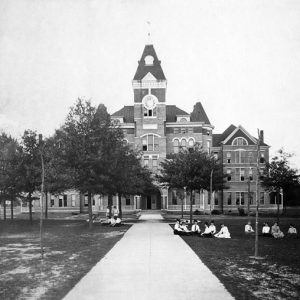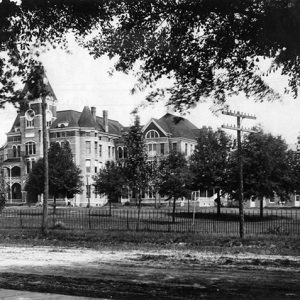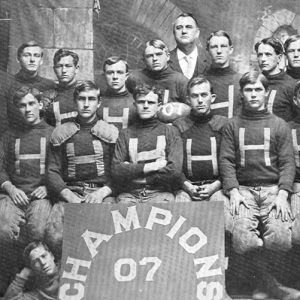calsfoundation@cals.org
Henderson-Brown College
Henderson-Brown College (HBC) was a private, co-educational college located in Arkadelphia (Clark County). HBC served as a Methodist institution of higher learning in the southern part of the state. It exists today as Henderson State University.
HBC was founded in 1890 as Arkadelphia Methodist College. Local members of the Methodist state convention had decided to start a college to serve students in southern Arkansas and to compete with Ouachita Baptist College (now Ouachita Baptist University), also located in Arkadelphia. The school was the third Methodist college in the state, joining male-only Hendrix College in Conway (Faulkner County) and Galloway Female College in Searcy (White County). Arkadelphia Methodist College was the first co-educational school in the Methodist state convention.
Methodist citizens in Arkadelphia originally tried to secure Hendrix College for Arkadelphia when its location was moved in 1889 from Altus (Franklin County) to Conway but were unsuccessful in their efforts. With $30,000 and a location already pledged to the school, the citizens of Arkadelphia set out to create their own school. After receiving the blessing of the board of education of the Little Rock Conference of the Methodist Church, a fifteen-member board of trustees was selected and immediately set out to create a school. On April 19, 1890, a nine-acre campus, located north of Arkadelphia, was purchased from Harriet Barkman. The new campus was separated from Ouachita Baptist College by two ravines and several blocks. Architect Thomas Harding was contracted to build a structure to house the college. The first term was scheduled to begin the first Wednesday in September 1890.
One hundred and ten students arrived to start the first term on September 3, 1890. The classes were held in the public school building, and the students were housed in private homes around Arkadelphia. Students took classes in mathematics, natural and physical sciences, mental science, English, history, and reading. Upon completing the required courses, men were awarded the bachelor of philosophy degree, while women received the mistress of English literature degree. Bachelor of science, bachelor of arts, and artium magister (MA) degrees were also awarded. A preparatory department was also established, and children of local citizens attended classes during the day.
The college slowly grew through the 1890s, adding a kindergarten and education classes in 1896. Participation in debate and oratory competitions led to the adoption of the original school colors, cream and pink. In 1893, the main building was finally ready to be occupied. Housing everything from the library and classrooms to the women’s dormitory, the new building quickly became the center of campus. Housing for men did not open until 1903, when a former private residence was converted to that use. Sidewalks linking the campus on Henderson Street to the Methodist church and Ouachita Baptist College were also completed in the early 1900s. The early twentieth century also marked the establishment of the Star yearbook in 1905 and the Oracle newspaper in 1908.
With the campus’s growth, the size of the student body also grew through the 1890s, but by 1905, the number of students taking collegiate-level classes began to drop. But by 1909, the school was debt free, largely due to the work of prominent Arkadelphia citizens and, to a lesser extent, the Little Rock Conference of the Methodist Church.
In 1904, the name of the institution was changed for the first time. In honor of Captain Charles Christopher Henderson’s service on the board of trustees and his continued financial support of the college, the name of Arkadelphia Methodist College was changed to Henderson College at the annual commencement. In 1911, the name of Henderson College was expanded to Henderson-Brown College, in honor of Walter William Brown, business partner of Henderson and a member of the board of trustees.
Athletics soon became an important part of the school. By 1906, basketball, baseball, track, and football were all being played at the college. The most popular game quickly became football. In 1907, the first “Battle of the Ravine” was played against rival Ouachita Baptist College. By now, the school colors had been changed to red and gray. The athletic teams were first known as the Red Jackets or the Red Men but by 1908 were simply the Reds. Soon, that name evolved into the Reddies (and Lady Reddies), the name that remains to this day. The school also remains without a traditional mascot.
Tragedy stuck the college early on the morning of February 3, 1914. A fire broke out in the main building and quickly engulfed the entire structure. Thanks to the efforts of the male students of both Henderson-Brown and Ouachita Baptist, the entire library, several pianos, and countless personal effects were saved. The building itself was a total loss. Subsequently, the entire student body met under a pine grove near the remains of the building and discussed the next step in the future of the college. Out of an enrollment of nearly 300, only seven students decided to leave. The decision of most of the students to stay and rebuild their school is known as the birth of the Reddie Spirit.
New structures were built to replace the main building, and classes continued in tents and in classrooms at Ouachita Baptist College. The first men’s dormitory was built in 1920, and a new academic building known as College Hall was finished in 1915.
By 1929, enrollment stood at 153, a drop of fifty from just the year before. The Little Rock Conference decided after much debate to consolidate Henderson-Brown College and Hendrix College and create one co-educational institution of higher learning in Little Rock (Pulaski County) and turn both campuses over to the cities in which they lay. (The move to Little Rock never occurred; Hendrix remained in Conway.) The student body of Henderson-Brown strongly opposed the merger, as did most of the administration and the public. After negotiations with state lawmakers, it was decided to turn control of Henderson-Brown over to the state rather than close its doors. Thus, in 1929, the institution became known as Henderson State Teachers College. The name of Hendrix College was changed to Hendrix-Henderson College and remained so for about two years before once again becoming Hendrix College. According to the state convention, Henderson-Brown no longer existed in Arkadelphia.
For additional information:
Bledsoe, Bennie Gene. Henderson State University: Education since 1890. 2 vols. Houston, TX: D. Armstrong Co., 1986.
Hall, John G. Henderson State College: The Methodist Years. Arkadelphia, AR: Henderson State College Alumni Association, 1974.
Henderson State University. http://www.hsu.edu (accessed September 7, 2023).
Sesser, David. The School with a Heart: Henderson State University at 125. Arkadelphia, AR: Henderson State University, 2017.
———. “‘A Spirit of Unrest’: The 1928 Student Strike at Henderson-Brown College.” Pulaski County Historical Review 64 (Summer 2016): 50–68.
David Sesser
Nevada County Depot and Museum







Comments
No comments on this entry yet.